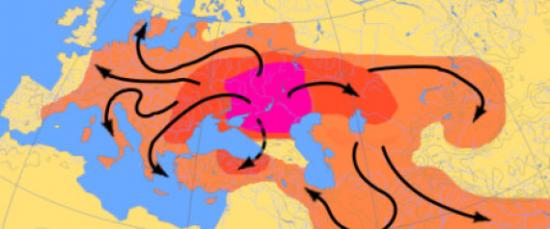Meredith Bennett-Smith
Source - http://www.huffingtonpost.com/2013/09/28/proto-indo-european-language-ancestors_n_4005545.html

Map of Indo-European migrations from ca. 4000 to 1000 BC according to one theory, the Kurgan hypothesis. | Wikimedia Commons
What did our ancient ancestors sound like?
Between approximately 4,500 and 2,500 B.C, the ancestors of much of Europe and Asia once spoke the same mother tongue, a language referred to as Proto-Indo-European, or PIE. Although there is no written record of such a language, linguist Dr. Andrew Byrd recently attempted to reconstruct his own recordings of PIE language for Archaeology magazine, building off three centuries' worth of scholarly work on the topic.
Byrd is an expert in ancient Indo-European linguistics, focusing on phonology, and teaches at the University of Kentucky. For his recording, he edited and recited his own version of a reconstructed PIE fable known as "The Sheep and the Horses," as well as a version of a Sanskrit story called “The King and the God.”
"The Sheep and the Horses" is an interesting case because it was actually written in 1868 by German linguist Dr. August Schleicher, who then translated the story into PIE as a way to experiment with the vocabulary, according to Archaeology.
In an interview with The Huffington Post, Byrd said that his recording of "The Sheep and the Horses" was "an approximation" of what PIE originally sounded like and is largely based on our knowledge of the texts of ancient Indo-European languages, such as Latin, Greek and Sanskrit. Byrd's rendition of the "The Sheep and the Horses" largely derives from a text originally composed by a mentor, UCLA linguist Dr. H. Craig Melchert. That text in Proto-Indo-European, as reprinted from Archaeology, reads thus:
 AUDIO = http://io9.com/listen-to-what-our-ancestors-language-sounded-like-6-0-1403832049
AUDIO = http://io9.com/listen-to-what-our-ancestors-language-sounded-like-6-0-1403832049
Here is the passage translated into English:
A sheep that had no wool saw horses, one of them pulling a heavy wagon, one carrying a big load, and one carrying a man quickly. The sheep said to the horses: "My heart pains me, seeing a man driving horses." The horses said: "Listen, sheep, our hearts pain us when we see this: a man, the master, makes the wool of the sheep into a warm garment for himself. And the sheep has no wool." Having heard this, the sheep fled into the plain.
Although there is no way to create a definitive version of the language, Byrd told HuffPost that his pronunciation is "still a very educated approximation."
"Languages differ on how they pattern their sounds together," Byrd explained. "And they use those sounds to create new words. Proto-Indo-European is very guttural."
Somewhat surprised by the viral success of his recording, Byrd said he doubts that he will make any further recordings, in large part because he'd have to create new narratives to translate. The researcher added, however, that he was pleased the media attention has helped bring Indo-European linguistics into the mainstream.
Some of the many modern languages that stem from the Indo-European family include English, Swedish and Farsi. Byrd told HuffPost that this ancient connection is often forgotten in the context of today's geopolitical climate.
"Farsi and English were 6,500 years ago the same language," he said. "That's pretty cool, and it kind of gives you a sense of unity."
Because of the lack of available information, PIE is a debated topic among researchers. Byrd believes PIE was probably spoken on the Eurasian steppes around 6,500 years ago; but, he added, other researchers recently introduced a controversial new theory that it was spoken several thousand years earlier in Turkey.
Asked what it would take to create a completely definitive PIE recording, Byrd just laughed. "A time machine?" he mused.